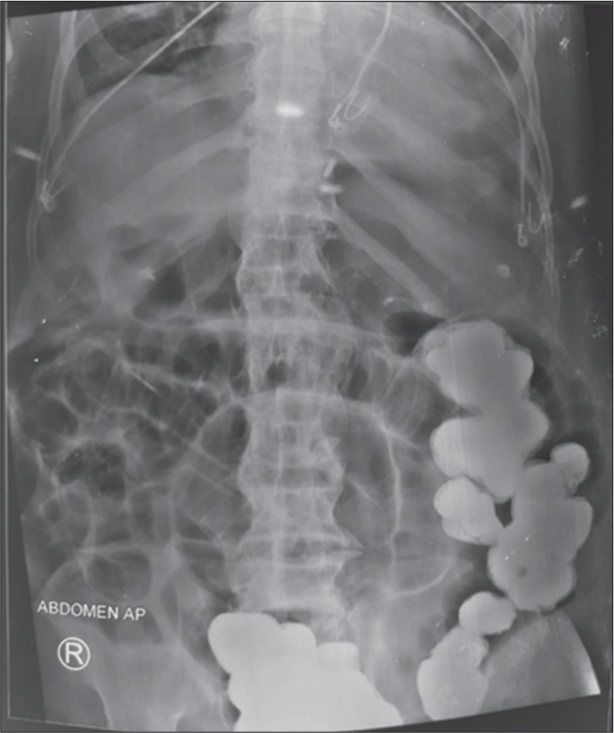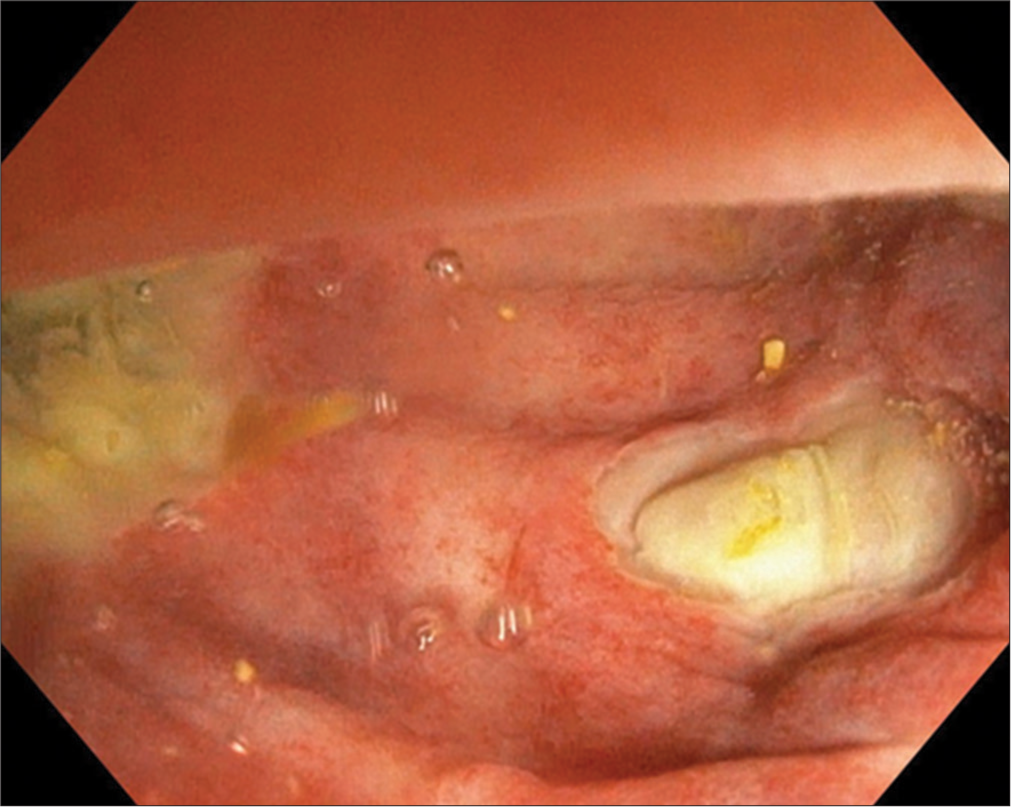Translate this page into:
Intestinal Obstruction Following Barium Swallow
*Corresponding author: Dipti Anil Chand, Department of Medicine, KIMS-Kingsway Hospital, Nagpur, Maharashtra, India. dachand.ngp@gmail.com
-
Received: ,
Accepted: ,
How to cite this article: Chand DA, Agrawal R, Barokar R, Patil S, Deotale RR. Intestinal Obstruction Following Barium Swallow. Vidarbha J Intern Med. 2023;33:113-4. doi: 10.25259/VJIM_8_2024
Abstract
Intestinal obstruction following a barium examination is a rare complication. We report a case of distal large bowel obstruction caused by large barium plugs – Baroliths, occurring a few weeks after a barium swallow.
Keywords
Intestinal obstruction
Barolith
Colonoscopy
INTRODUCTION
A barolith consists of inspissated barium associated with feces and is seen, rarely, after barium studies for imaging the gastrointestinal system. We present a case of elderly male presenting with barolith impaction leading to intestinal obstruction following barium swallow.
CASE REPORT
An 86-year-old man was hospitalised in the intensive care unit with respiratory failure due to a bilateral lower respiratory tract infection. He had a history of choking sensation on eating, for which he underwent a barium swallow test two weeks before admission. On admission, he had bilateral chest infiltrates and was hypoxic. He was intubated and ventilated and was being treated for a lower respiratory tract infection. However, two weeks after admission, he developed intestinal obstruction and was imaged. His plain film abdomen showed large and small gut obstructions along with radiopaque shadows in the colon suggestive of baroliths [Figure 1]. The colonoscope initially was not negotiable across the hard baroliths. He was then given a polyethylene glycol enema and subsequently colonoscopy was done, with which the impacted baroliths were removed [Figure 2].

- X-ray abdomen barolith impaction.

- Colonoscopic removal of baroliths.
DISCUSSION
Barium contrast is a commonly used tool in diagnostic radiographs for patients with abdominal disease. In rare instances, it can cause a barolith which is inspissation/ impaction of barium contrast in the bowel. Barolith obstruction has shown a delayed presentation by many weeks or months after the examination.[1] Our patient developed obstruction a few weeks after his barium swallow. Considering the study by Borden and Herwel,[2] in which 57% of patients cleared barium from the colon within a week of a barium study and by four weeks in the remainder, it remains theoretically possible for an early obstruction to occur. The risk factors for barolith formation include advanced age (as in our case report), low-residue diet, dehydration, poor colonic motility and colonic stenosis.[3] Barium has the potential to cause obstruction, as it is a highly insoluble material and must be finely pulverised and mixed with dispersing agents to allow suspension in water. [4] If the patient’s bowels are sluggish, they can become pre-disposed to excessive water re-absorption and inspissation of the barium, which could subsequently lead to intestinal obstruction. Various non-operative options for the successful dissolution of uncomplicated baroliths have been reported in the literature. These have included lactulose, oral gastrografin and colonoscopic lavage.[4] Barolith obstruction is a rare event, and our report suggests that it should be looked for, especially in elderly subjects.
Ethical approval
The Institutional Review Board approval is not required.
Declaration of patient consent
The authors certify that they have obtained all appropriate patient consent.
Conflicts of interest
There are no conflicts of interest.
Use of artificial intelligence (AI)-assisted technology for manuscript preparation
The authors confirm that there was no use of artificial intelligence (AI)-assisted technology for assisting in the writing or editing of the manuscript and no images were manipulated using AI.
Financial support and sponsorship
Nil.
References
- An Unusual Cause of Bowel Obstruction: 1477. Am J Gastroenterol. 2018;113:S848.
- [CrossRef] [Google Scholar]
- Barium Fecoliths Following Gastrointestinal Radiography. Am J Gastroenterol. 1959;32:573-6.
- [Google Scholar]
- Large Bowel Obstruction Due to an Impacted Barolith a Delayed Complication of a Barium Study. Postgrad Med J. 1990;66:684-5.
- [CrossRef] [PubMed] [Google Scholar]
- Colonoscopic Dissolution of a Barolith. J Clin Gastroenterol. 1994;19:265-6.
- [CrossRef] [PubMed] [Google Scholar]






